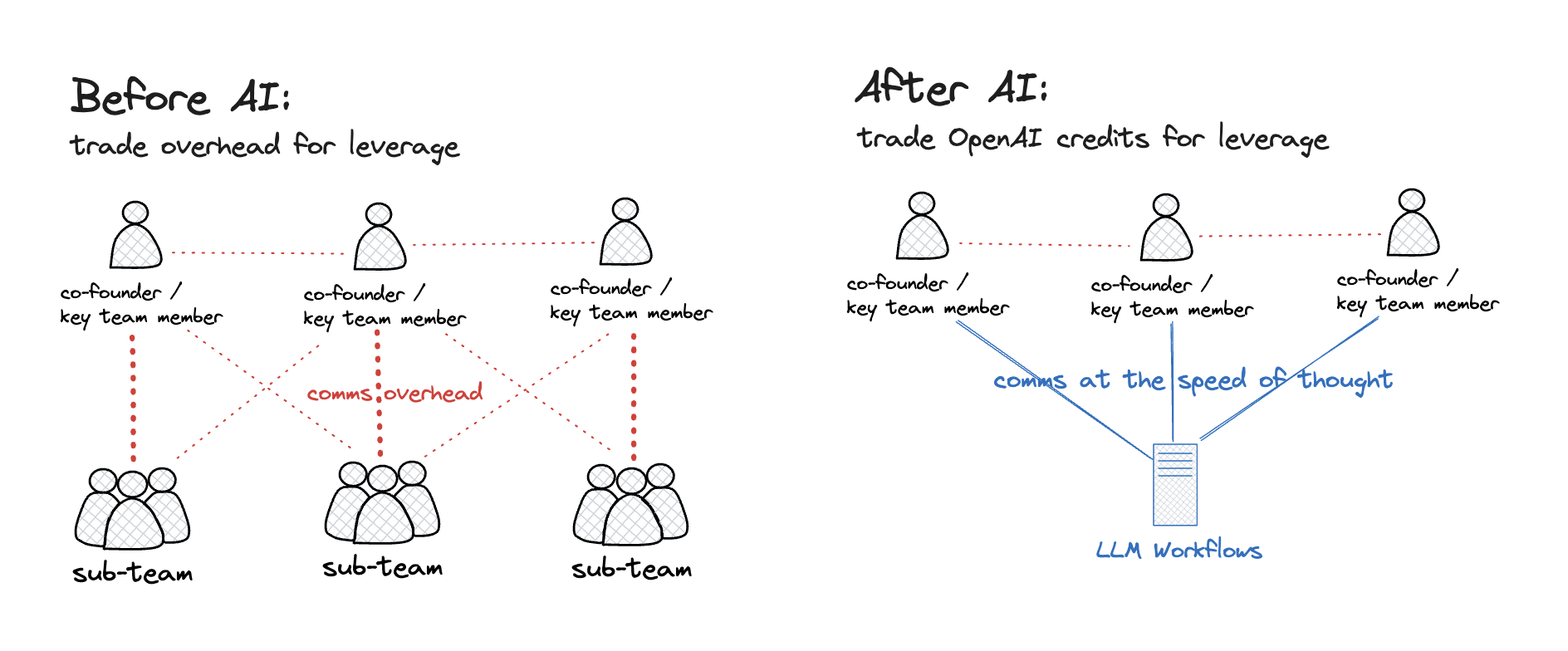Small Teams
One of the things I currently believe about working is this: small teams are the future.
Historically, if you wanted to do something ambitious, you needed a big team to move fast. You built a hierarchy: a few high-agency people moving ideas from concept to completion, managing sub-teams who executed under their guidance. Scaling meant hiring more people to increase throughput.
That made sense when people were the only way to get leverage. It makes less sense now. Today, AI agents can take on much of the work we used to hire for.
AI as Leverage
AI agents are already good at following instructions and producing output - code, writing, media, graphics, film, anything that lives in the information space. They’re getting faster and more accurate, often outperforming a human team member in both speed and quality.
If you’re a high-agency person, you can get more done with an army of AI agents than you could with a team of humans. And with fewer humans, you have less communication overhead. You spend more time producing and less time talking.
The Bottleneck Has Moved
Five years ago, if you wanted to ship software quickly, the bottleneck was how many good engineers you could hire. Even building an MVP often required three engineers just to move fast enough. Today, that’s overkill - and in many cases, a slowdown. One good engineer using AI can often move faster than a small team.

This also changes the economics. Most startup capital went toward hiring. If you can do the work with two or three people and AI leverage, you might not need to raise money at all. In some cases, it’s faster and less distracting to fund your own runway with a small amount of consulting work than to spend months pitching investors.
Hiring in the Age of AI
Before, you hired people for “manpower” - engineers to build features, salespeople to sell them. Now, you hire for functions AI can’t do well yet: rare expertise, deep domain knowledge, exceptional judgment.
I wouldn’t hire a junior or mid-level engineer right now. Models like Claude Opus or GPT-5 already operate at roughly that level - except they’re faster, always available, and cost far less. Any hire introduces communication overhead, so they have to be worth it.
We’re also exploring a heavy revenue-share model for compensation. It naturally keeps the team small. Every new hire reduces everyone’s short-term pay, so the hire must increase revenue enough for everyone to come out ahead.
Building Small From Day One
It’s easier to start small than to shrink later. Turning a big pre-AI team into a tiny one means rethinking processes and letting go of people. New teams can build for AI from day one.
That’s what we’re doing. Right now, it’s just two of us full-time - one on the business side, one on the development side - plus a part-time designer. Small teams are part of our founding myth. We think constantly about how to scale with AI instead of people.
On the engineering side, our codebase is structured with rigid architectural rules embedded directly into our coding agents’ system prompts. That means the business lead or designer can add features without knowing the underlying code. With GPT-5, these agents now produce clean, on-spec, and mostly production-ready code.
We’ve set up onboarding scripts that a coding agent can run automatically to configure dev environments and sync changes, so anyone can start contributing in minutes.
Breaking Down Silos
The aim is to let people express ideas directly in code or design without long documents, meetings, or translation loops. Prototypes should be close enough to production quality that merging them takes minimal rework.
The same principle applies to business and design. Every meeting and customer call is recorded and transcribed. Large-context models let anyone on the team mine this data for insights, even if they weren’t there. On the design side, we’re building a design language - standardized styling, reusable components, and prompt rules - so the rest of us can prototype visually with consistent results.
The Phantom Teammate
The overarching principle: each person works on frameworks, tools, and prompts that let the AI work as they would. For engineering, that’s architecture and rules. For design, style guides and components. For business, shared prompts for insight extraction.
The effect is that everyone creates a “phantom” version of themselves - an on-demand AI proxy that the rest of the team can leverage at any time.
Still Early
This is still an experiment. We’re at the edge of organizational design, thinking from first principles. It takes time, but if we discover even a few powerful frameworks, they’ll give us enormous leverage.
I believe that in the age of AI, work can be more productive, more creative, and more fun - with the boring parts handled by ever-growing armies of agents. The small, AI-enabled team might not just be faster - it might be the most exciting place to work.
other essays: